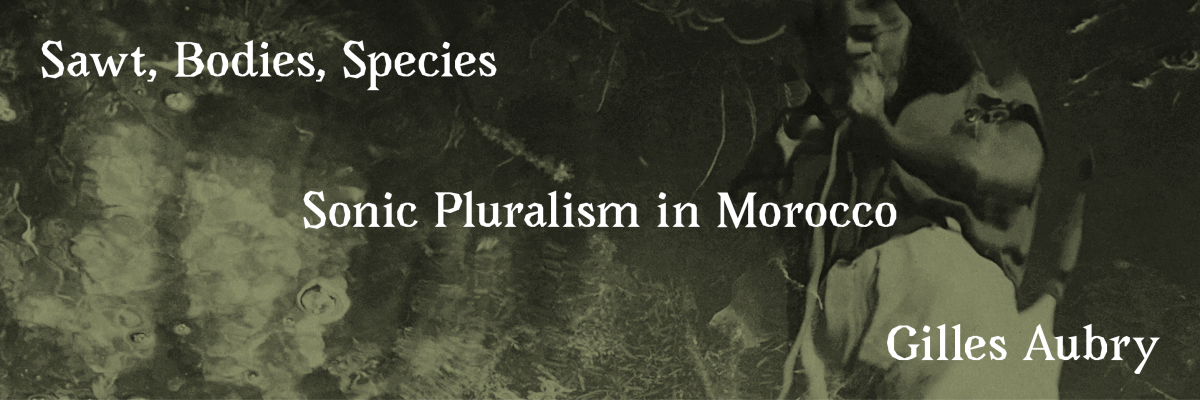
This Special focuses on sound, aurality, and ecology in Morocco. In exchange with artists, musicians, and scientists, Gilles Aubry’s more-than-sonic approach covers a wide range of practices, including music archives, seismology, healing practices, industrial extractivism, and inter-species co-evolution. Sawt, in Arabic, literally means sound and voice. Sound in Morocco thus intimately relates to the body as a site from which it becomes possible to re-work the borders of knowledge and coloniality. The transformative power of sonic pluralism is expressed in people’s acts of listening and sounding. The six chapters of his book, published by adocs in 2023, come with a number of collaborative audio and video essays, images, quotes, and reviews presented below. Order the book or access a full PDF here. Edited by Gilles Aubry.
- Response by Fatima-Zahra LakrissaSpeaking from the perspective of a researcher in art history and curatorial practitioner in Morocco, our author considers the idea of experimentation as one of the central aspects of Gilles Aubry’s book «Sawt, Bodies, Species».
- Interview by Gilles Aubry, Ahmed EssyadAn extended conversation with the Moroccan composer about performance in electroacoustic music, cultural roots and identity, the importance of music, the voice and the body, nature and ecology, and many more topics.
- Short Essay by Zeynep BulutInspired by Gilles Aubry’s video essay «Atlantic Ragagar», our author reflects on the relationship between water, body, voice, and language. Bulut calls for a critical approach towards voice and language, and a practice of listening with others.
- Response by Bhavisha PanchiaCurator and researcher Bhavisha Panchia crafts a thoughtful response to Gilles Aubry’s «Sawt, Bodies, Species: Sonic Pluralism in Morocco», detailing that the book is a conscious revisit of what it means to listen to and through sonic and musical heritage.
- Introduction by Gilles AubryIn this introduction to his book «Sawt, Bodies, Species», Gilles Aubry situates his research project on the sonic dimensions of our environment, tracing alternate genealogies of sound, listening, and technology in North Africa.
- Book Chapter by Gilles AubryThe 1960 earthquake in the Moroccan city of Agadir and its aftermaths reveal a heterogenous «unsound» field, between state-supported technocratic listening and Indigenous sonic virtuality.
- Sound Piece by Gilles Aubry, Ramia BeladelInformed by Ramia Beladel’s research on Sufi healing, this sound piece relies on trance and self-reconfiguration. The soundtrack includes sounds recorded during an annual celebration of the local saint in Moulay Bouchta, Morocco.
- Book Chapter by Gilles AubryA series of joint experiments in stone sounding with the Moroccan artist Abdeljalil Saouli leads to a decolonial dialogue on sonic materialism and posthumanism.
- Video Essay by Gilles AubryA violent earthquake destroyed the city of Agadir, Morocco, in 1960. Shot inside the Salam movie theater and its surroundings, the video essay is a tentative reconstitution of the earthquake as a sonic moment.
- Book Chapter by Gilles AubryWith a short history of sound technology and music industry in Morocco since the early 20th century, the chapter proposes a close listening to early Moroccan rwais music recordings with the singer Ali Faiq.
- Quotation by Mohamed Anjjar
«We didn’t know we were being recorded, I find that outrageous!»
- Book Chapter by Gilles AubryMoroccan visual artist Ramia Beladel’s performative art practice on popular Sufism provides a starting point for considering sonic experience from the perspective of gender and embodiment.
- Video Essay by Gilles Aubry, Zouheir AtbaneA film without images documenting the authors’ research in Tafraout, Morocco, a village where Paul Bowles recorded an ahwash music performance in 1959. In exchange with local musicians, the two artists engage in listening sessions and sonic experiments.
- Book Chapter by Gilles AubryIn 1959, the American writer Paul Bowles recorded an ahwash music performance in the Moroccan Berber town Tafraout in 1959. In 2013, Gilles Aubry initiated a research on the reception of these recordings in today’s Morocco during listening sessions with local musicians.
- Video Essay by Gilles AubryAn experimental film on seaweed and industrial extractivism on the Moroccan Atlantic coast, inviting the spectator into a process of ecological transformation.
- Video Essay by Gilles Aubry, Abdeljalil SaouliThis video is a documentation of a joint experiment in stone sounding in Moulay Bouchta, Morocco, featuring statements by the Moroccan artist Abdeljalil Saouli on the nature of stone and of sound itself.
- Book Chapter by Gilles AubryThe scientific research on seaweed of the biologist Younes Boundir provides an entry point into industrial extractivism and ecological justice in Morocco.
- Quotation by Younes Boundir
«The sea can tell stories! One simply has to listen to them.»
- Video Essay by Gilles AubryAs part of the research project on sound, ecology, and seaweed production, this video documents a collective baking session with a group of women who collect seaweed for a living in Sidi Bouzid on the Moroccan Atlantic Coast.

















